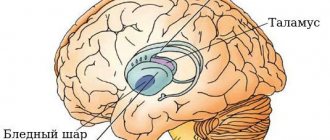Symptoms of rhinolalia
With open organic rhinolalia, the cause of which is various congenital anomalies, the baby’s vital functions such as breathing and nutrition suffer from the very first hours of his life.
As a rule, the sucking reflex in such children is preserved, but feeding becomes difficult, since the child does not latch on to the breast, and when bottle-fed, the mixture flows out through the nose, as a result of which the newborn does not receive the nutrients it needs and is significantly delayed in development. Since nasal breathing is impaired, such children often suffer from chronic inflammatory diseases of the respiratory system, which causes the development of rhinolalia. Among other things, congenital cleft palates are accompanied by various malocclusions, which only contributes to speech problems. This is often due to the fact that in such children the preservation of intelligence varies from normal to very significant developmental delays.
Speech development—both in the prelinguistic period and during the period of speech development—proceeds abnormally. There is no characteristic babbling. Or it is very quiet, barely noticeable. The child begins to pronounce his first words at the age of more than 2 years; his speech is illegible and slurred, and is difficult for others to understand.
With open organic rhinolalia, all sounds have a pronounced nasal connotation, and the child has impaired articulation and pronunciation of sounds. All consonants are more reminiscent of the sound “x”, they cannot be distinguished from each other. The voice is quiet and dull. Trying to pronounce sounds correctly, the child uses the facial apparatus or strains the muscles of the lips, wings of the nose or tongue, which only aggravates the situation.
Problems with speech also affect auditory perception and the ability to phonetically analyze spoken speech. In addition, due to limited communication with peers, these children have a rather poor vocabulary and have problems with written speech. The combination of such changes can lead to the fact that in a child with open organic rhinolalia, speech therapists are forced to note general speech underdevelopment. At the age when the child begins to realize his defect, changes in the speech apparatus are accompanied by various mental disorders and associated layers: isolation, irritability, shyness, etc.
In patients with open functional rhinolalia, the pronunciation of vowel sounds suffers to a greater extent. Such a child pronounces consonants quite well, which is associated with velopharyngeal closure that is quite sufficient for this. With closed functional rhinolalia, as a rule, only the timbre of the voice suffers, which takes on an unnatural, dull, “dead” hue.
Closed organic rhinolalia is characterized by distortion of consonant sounds. The child often changes the sound “m” to the sound “b”, “n” to “d”, etc. With this form of pathology, nasal breathing is difficult, and therefore the child constantly breathes through the mouth, which leads to the fact that such children are susceptible to various inflammatory diseases of the upper respiratory tract, and also often suffer from chronic forms of bronchitis and pneumonia, which have a recurrent course.
Examination of children with rhinolalia
If a child has a congenital cleft palate, then a systematic approach is used in the treatment of rhinolalia. In addition to a thorough study of the structure and operation of the articulatory apparatus, respiratory and vocal function, a speech therapy study of the state of sound pronunciation, phonemic perception, and the development of vocabulary and grammar is mandatory.
Stage 1 – instrumental methods
At the 1st stage, the examination is carried out by doctors who use special methods. Radiography
is necessary to establish the anatomical and physiological structure of the child’s speech apparatus, the mobility of the soft palate, the characteristics of the velopharyngeal closure, and the activity of the pharyngeal muscles.
The study of timbre and pitch of the voice reveals spectral analysis. The X-ray tomography
method studies the position of the speech organs, the degree of mouth opening, and the direction of tongue movements.
The spirometry
method provides data on respiratory function and lung capacity.
Using rhinoscopy,
the structure and growth in the nasal cavity are studied.
A phonendoscope
examines the presence of submycotic clefts (Gutsman test). Using syllable tables, speech intelligibility is studied (audit analysis method). Only after a medical examination is a diagnosis made: open, closed or mixed rhinolalia.
Stage 2 – psychological examination
The second stage is a psychological examination. Specialists examine the state of memory, attention, thinking, emotional-volitional sphere, communication skills, features of the child’s mental development, leading activities, level of sensory development, general and fine motor skills.
Doctor's reportAt the final stage, the verdict is made by a speech therapist, who must determine which components of speech have suffered due to the defect, what is the severity of speech disorders, what is primary and what is secondary. Speech therapy examination includes:
|
Schoolchildren are examined in reading and writing.
The speech therapist makes a conclusion: FN (phonetic disorder), FFN (phonetic-phonemic disorder), GSD (general speech underdevelopment).
Up
Diagnosis of rhinolalia
The examination of children and adults with rhinolalia is multifaceted and is carried out by various specialists:
- otolaryngologist;
- speech pathologist;
- speech therapist;
- neurologist;
- orthodontist;
- phoniatrist;
- pediatrician
An examination by specialized specialists allows us to identify the etiology of the disease, characterize as accurately as possible the nature of pathological changes and the severity of all symptoms. The following instrumental diagnostic methods are important:
- X-ray of the nasopharynx;
- rhinoscopy;
- electromyography;
- pharyngoscopy, etc.
These techniques make it possible to visualize the nature of pathological changes and their severity in each individual patient.
Of course, the most significant is an examination by a speech therapist, who, using a number of progressive techniques, will be able to assess the following parameters:
- structure of the articulatory apparatus;
- his mobility;
- voice disorders;
- parameters of physiological and phonation breathing, etc.
To diagnose open rhinolalia, the Gutzmann technique is used, which is based on the fact that the patient pronounces the sounds “a” and “i” alternately, while the doctor opens and closes the nasal passages. In the presence of pathological changes, the vibration of the wings of the nose is very clearly felt, and when the nasal passages are pinched, the sounds are significantly muffled. Thus, it is possible to diagnose the open form of rhinolalia.
Ermakova Violetta Valentinovna.
Novosibirsk, MUZ NSO Children's City Clinical Hospital SMP, speech therapist, [email protected]
Annotation. The article provides brief characteristics of voice impairment due to rhinolalia. An overview of phonopedic techniques used in the correction of rhinolalia by various authors is offered.
Key words: rhinolalia, phonopedia, resonance, resonance, orthophonic method.
In recent years, the scope of phonopedia has expanded significantly. The need has clearly emerged not only to eliminate voice disorders themselves, but also voice disorders that are part of the structure of a speech defect in rhinolalia, dysarthria, and stuttering.
Voice disturbances in rhinolalia can be both organic and functional. With congenital cleft palate, the voice is significantly impaired: its timbre is nasalized, strength is reduced, and hoarseness is pronounced. The imbalance of oral and nasal resonance is due to an organic cause - cleft palate; all other signs of a voice defect are functional and develop gradually. I.I. Ermakova indicates three causes of functional insufficiency of the vocal apparatus in adolescents and adults with cleft palates:
- functional changes in the muscles of the palate and pharynx, which are normally reflex stimuli of the vocal folds;
formation of articulation of some voiced consonants in a lyringeal way;
- characterological characteristics of people with clefts.
According to research by I.I. Ermakova [4, p. 8] 70–80% of people with congenital cleft palate have functional disorders in the form of hypotonicity of the vocal folds and phonasthenia. The sound of the voice and the phonation mechanism in cleft palate are so specific that M. Zeeman [5, p. 100–112] identified the voice in rhinolalia as an independent disorder and called it palatophonia. And modern phoniatrics generally classifies rhinolalia as a voice disorder.
Speech therapy work on the correction of rhinolalia begins in childhood and in the early stages is nothing more than specially selected phonopedic exercises. Measures that help improve the voice of children before plastic surgery of the palate include the establishment of physiological and phonation breathing, the prevention of dystrophy of the muscles of the pharynx and palate. After the operation, work on the voice includes breathing exercises that lengthen exhalation, activate the mobility of the diaphragm, strengthen the velopharyngeal closure, establish a balanced resonance, develop correct voice guidance, expand the range of the voice, increase its strength, in addition, compensation for disorders of the motor function of the larynx. Such work is subject to general didactic principles: consistency, systematicity, activity, motivation, and it is also necessary to take into account the individual and age characteristics of the child.
In phonopedic work when correcting rhinolalia, there are three stages: preparatory; formation of a new mechanism of voice formation; consolidation and automation of speech stereotypes.
The first stage is the weakening of pathological connections, preparing the respiratory and vocal apparatus for subsequent vocal exercises. At this stage, it is advisable to use breathing exercises to differentiate nasal and oral exhalation, physiomechanotherapeutic effects on the muscles of the soft palate, the posterior wall of the pharynx, massage of the soft palate, as well as psychotherapy.
The second stage is the formation of speech breathing skills, a new stereotype of voice formation. At the second stage, special attention is paid to specific techniques aimed at activating the movements of the soft palate in case of violations of nasal resonance. Work on resonance plays a huge role in the correction of rhinolalia and includes several components:
adjustment of the resonator-articulation system using auditory and vibration sensations;
strengthening the resonator-articulation system;
- improvement of the sound resonance system.
The next direction of work at the second stage of phonopedic correction is expanding the sound range:
- development of voice power;
- development of voice pitch;
- development of voice timbre;
- improving the intonation side of speech.
The third stage is consolidation of acquired skills.
Children with rhinolalia usually have insufficient thoracic resonance activity. In this case, voice exercises are recommended with the pronunciation of vowel sounds a, e, o, and, y with a focus on the degree of lifting and tension of the palatal curtain, which are enhanced by artificially induced vibration (for example, tapping on the chest). According to the method of I.I. Ermakova’s child repeats vowels after the speech therapist. The speech therapist pronounces vowels loudly, but not tensely, with a soft attack, with an open sound. The number of vowels in combination gradually increases to three sounds. The pronunciation of vowels is carried out in order of orientation to the degree of elevation of the velum palatine.
Increasing the strength of the voice and expanding its range is most easily achieved through vocal exercises. Starting with chanting thirds or triads. Then they begin to sing short musical phrases and songs. The use of vocal exercises in correctional work with children with velopharyngeal insufficiency is based on the phylogenetic and functional connection of the soft palate and larynx. When singing, the muscle tone of the palate increases sharply with an increase in muscle tone in the larynx and pharynx. The soft palate reflexively rises and adjoins the back of the pharynx. To expand the range, increase the strength of the voice, and develop intonation, the exercises are modified: they change the key, sing either quietly or loudly.
Children with rhinolalia completely lack experience in many primitive actions: blowing, breaking the bows, feeling increased pressure inside the mouth, etc., which significantly reduces the formation of self-control skills. In this regard, the V.V. system is unique. Emelyanov [3, p. 37–39]. The exercises are structured according to the principle from simple to complex and are based on the fact that activation of the vocal function leads to the formation of new feedback channels, unconscious for the child himself, with the help of which work on correcting sound pronunciation will be effective.
After vocal exercises, the basic, most natural tone of the child’s voice is determined. The determination of the most convenient tone occurs when the child repeats after the speech therapist the imitation of the sound “m” at different heights, with attention focused on nasal resonance and a soft vocal attack. The speech therapist’s task is to let the child feel and remember this tone, which will become a reference tone for him. The choice of the “m” phoneme as the initial one when producing a voice is determined by its physiological basis, convenient for correct phonation. When pronouncing “m” with closed lips, lowered tongue root, a small gap between the teeth, the sound can be easily delivered “into the mask”. Initially, the phoneme is pronounced briefly, but then the sound is lengthened.
Once children begin to sense kinesthetically and can differentiate correct phonation by ear, they can begin subsequent exercises.
It is very important that correction of sound pronunciation in children with rhinolalia will be successful only if it is preceded by phonopedic correction.
The most effective method of rehabilitation of children with rhinolalia is the orthophonic method proposed by E.S. Almazova [1, p. 182], an integral part of which is phoniatric influence. The main goal of the orthophonic method is to restore the functional relationship between breathing, articulation and voice formation, obtain a loud, ringing, “flying” sound of the voice and consolidate it in the child’s independent speech.
Bibliography:
- Almazova E.S. Speech therapy work on voice restoration in children. – M.: Iris-press, 2005. – 182 p.
- Wilson D.K. Voice disorders in children [Text] / D.K. Wilson. – M.: Medicine, 1990. – 448 p.
- Emelyanov V.V. On the uneven development of the vocal apparatus and vocal function. – St. Petersburg: LOIRO, 1998. – 37–39 p.
- Ermakova I.I. Correction of speech and voice in children and adolescents. – M.: Education, 1996. – 143 p.
- Zeeman M. Speech disorders in childhood. – M.: Medicine, 1962. – 300 p.
- Lavrova E.V. Speech therapy. Basics of phonopedia. – M.: Medicine, 2007.
- Soboleva E.A. Rhinolalia. – M.: Astrel, 2006. – 126 p.
Correction of rhinolalia
Correction of rhinolalia should have a comprehensive approach. As a rule, congenital anomalies of the structure of the facial skull are subject to surgical correction. Congenital defects are corrected using plastic surgery. Such operations are aimed at restoring the anatomical structure of the organs of the nose and pharynx, as well as eliminating cosmetic defects.
In addition, some patients require surgical interventions to remove nasal polyps, adenoids and other pathological formations that interfere with normal nasal breathing. Correction of the bite and deformations of the upper jaw by an orthodontist is also required. Physiotherapy, special speech therapy sessions, and psychotherapy also play a significant role in the treatment process.
Rhinolalia is a complex and very diverse disease, the successful treatment of which requires the participation of specialists from many areas of modern medicine. In particular - speech therapy, dental surgery, otolaryngology, orthodontics, psychology.





